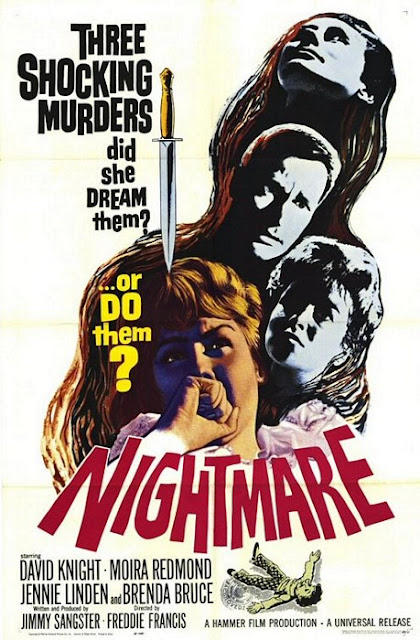Our film today wakes up with a scream; a scream that appears to happen on a nightly basis for a girl named Janet (Linden), a young teenager who has been plagued for nearly her whole life by some pretty vicious nightmares. Now, the fact that she witnessed both her mother's psychotic break and the end result of which -- ‘of which’ being the brutal murder of her father as a fourth birthday present, well, that would probably give all of us a bad case of the night-drizzles, too.
And worst of all, things seem to be intensifying, exponentially, lately; and now, poor Janet's greatest fear, the fear that she is destined to crack-up and kill somebody, and then wind up in the loony-bin just like dear old mom, appears to be a self-fulfilling prophecy fully realized as these nightmares are now, seemingly, continuing when she's wide awake!
Make no mistake, Janet was teetering on the brink of mental instability already; but is she really cracking up for good due to this childhood trauma? Or is someone (rather than something) using this to push this girl over the same homicidal edge as her mother for some other nefarious purpose..?
While Hammer Studios made their rep in the late 1950s and early '60s with a string of Technicolor Gothic romps, lost in all that free-flowing blood and tensile-cleavage were a string of psychological thrillers, shot in glorious black 'n' white, with the likes of The Snorkel (1958), Scream of Fear (1961), Paranoiac (1963), Maniac (1963) and Nightmare (1964).
These were all shot with an eye for Hitchcockian shocks and suspense -- Rear Window (1954), Psycho (1960), and an ear for the left-turn revelations of Henri-Georges Clouzot -- The Murderer Lives at Number 21 (1942), Les Diaboliques (1955). And though this was technically achieved, as the films are fundamentally sound and look absolutely gorgeous, but, they all hewed much closer to the completely mental mentality of William Castle -- Macabre (1958), House on Haunted Hill (1959), Homicidal (1961), as one salacious and convoluted plot twist after another keeps piling-up with each finished reel.
Still, they're all well worth a look and all are readily available in some form or another in one of those Hammer box sets from Columbia. The crisp and clean prints they have just pop off the screen and I can't recommend these discs highly enough.
Of course, it's almost impossible to throw a rock at Hammer's output from this period and not hit one that had Jimmy Sangster's fingerprints on it, including the script for Nightmare. Here, his plot of a demented perfect-murder (of an unwanted fiance) and money-grab (of Janet's estate) by a couple of unscrupulous lovers asks you to swallow a lot; but it never really falls apart until the final denouement, another twist on the twist, which kinda clunks, badly, when the bad guys get their comeuppance, making one wonder when exactly did the good guys sniff out the original conspiracy and maybe, just maybe, prevented the murder in the first place and saved both the victim's life and poor Janet a whole helluva lot of grief.
Also not helping matters, and one of my biggest beefs with film, is that the first half of Nightmare doesn't really jive properly with the second.
See, when we first meet Janet and watch as she's put through the wringer, Nightmare is just that: a straight up horror movie. And a darn good one, too. It's all very creepy, that builds and builds its maledicted momentum with each ghostly and ghastly encounter; but then the plug is abruptly pulled when we breach the twist, as Janet's mental tether finally snaps and she lashes out and murders someone -- someone mistaken for the ghost that's been tormenting her.
From there, after Janet is carted off to the nuthouse, we then quickly find out what's been really going on, which, sadly, puts a damper on all that hard won and accumulated tension, leaving the movie with nothing to do but kinda start over again with another character, Grace (Redmond), where things become less suspenseful -- no matter how hard it tries to recapture that momentum, and more convoluted.
Now, despite these plot hiccups and tactical blunders, Nightmare is an absolute feast for the eyes. Not since Robert Siodmak's The Spiral Staircase (1946) have I seen black this BLACK onscreen and used so well in frame to enhance the mood.
Noted cinematographer Freddie Francis, who had just controlled the lens for Jack Clayton's The Innocents (1961), most definitely brought his cameraman's eye to the director's chair. And his efforts, along with the film's actual cinematographer, John Wilcox, using the sets, lighting and framing to impend the dread and to show the isolation and the nerve-rattling crescendo of the mental disintegration of first Janet, and then, co-conspirator Grace, definitely and defiantly helps push Nightmare out of the morass of a hackneyed-mess and into the serviceable-thriller column for me, at least.
Originally posted on October 24, 2013 at Micro-Brewed Reviews.
Nightmare (1964) Hammer Film Productions :: Universal Pictures / P: Jimmy Sangster / D: Freddie Francis / W: Jimmy Sangster / C: John Wilcox / E: James Needs / M: Don Banks / S: Moira Redmond, Jennie Linden, David Knight, Brenda Bruce, George A. Cooper, Irene Richmond, Clytie Jessop















No comments:
Post a Comment